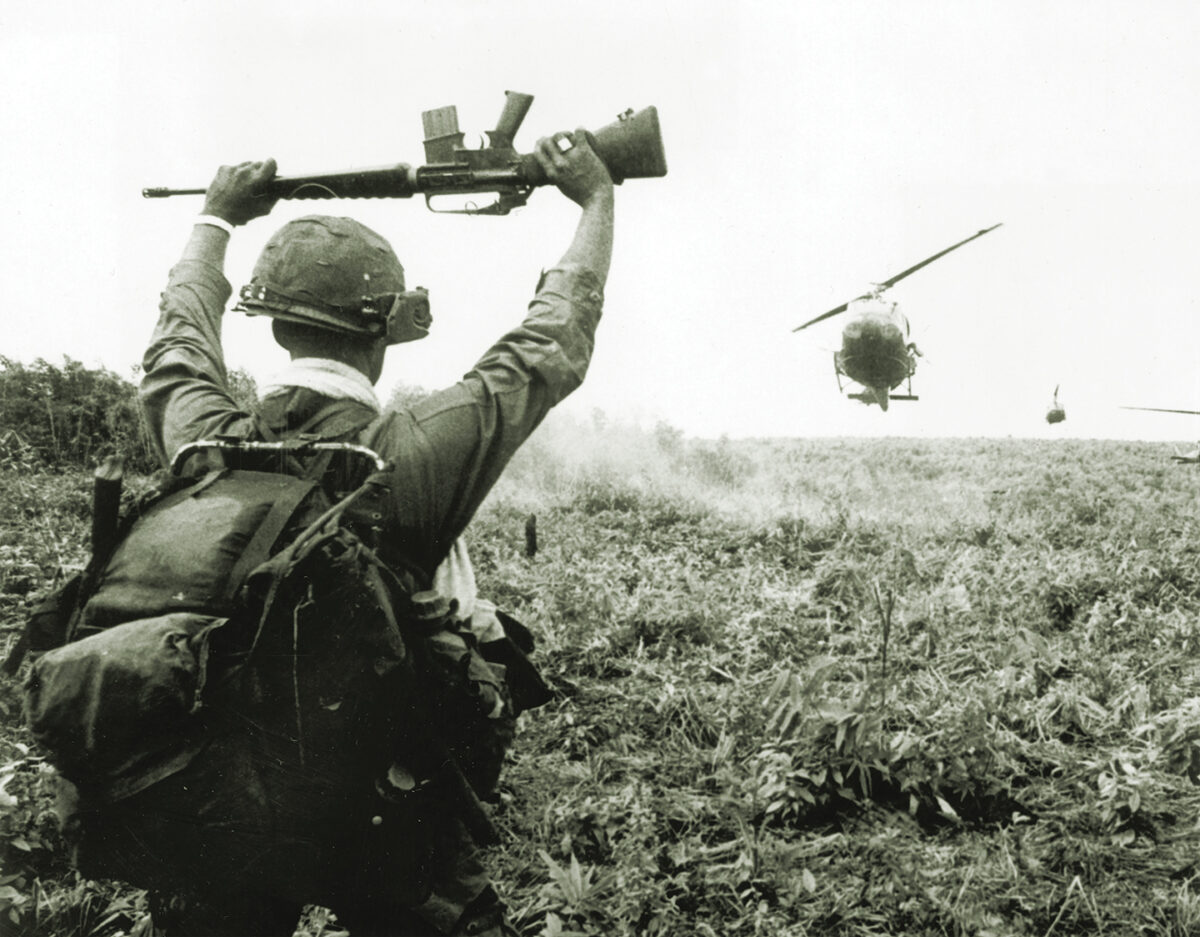John Haseman was a captain assigned as a Deputy District Senior Adviser (DDSA) in Mo Cay District, Kien Hoa Province, in the Mekong Delta. He had arrived at Advisory Team 88 in July 1971 and was DDSA in Ham Long District for 10 months before being reassigned to Mo Cay in May 1972.
Nov. 20, 1972, began as an ordinary day, at least at the start. My boss, the Mo Cay District Senior Adviser (DSA), had departed about a week earlier for much-deserved home leave that included several days of hospital care. He was seriously wounded during a major battle in July 1972 with an NVA regiment in which the Mo Cay District Chief had been killed in action. I was introduced to the new District Chief, Maj. Manh, before my superior departed for the U.S. At that time there were no main force Army of the Republic of Vietnam (ARVN) units stationed in the province; except for provincial and district level officers, the soldiers were all locally recruited Regional Force and Popular Force (RF/PF).
My first operational meeting with Maj. Manh had taken place several days earlier. A small convoy that included the newly assigned Province Intelligence (S-2) officer was ambushed just a few kilometers south of Mo Cay town. Manh hurried off with a small security force without telling me.
When told of the incident by Mo Cay’s communications officer, I quickly followed with my interpreter. When I arrived at the ambush scene, Manh’s first words to me were: “I did not tell you because I did not think you would go out to a dangerous area.” Apparently, he had experienced less-than-good relations with advisers during his previous duty in the 7th ARVN Division.
“Sir,” I responded, “I am your adviser while the DSA is away. You know much more about fighting this war than I do, but there are a lot of things I can do to help you. I want to go with you on all operations, dangerous or not. Please don’t leave me behind.”
Taken somewhat aback, he answered that he was glad to know it and would not leave me behind again.
The Explosion
On Nov. 20, I prepared to accompany Manh on my first combat operation with him—a two-company RF sweep through a contested part of western Mo Cay District. The operation line of march was centered on a seldom-used rural road. A company-sized unit would be about 200 meters out on each flank. The troops were well-spaced and well-led. There had been no enemy contact. My interpreter and I were with the command group, which included Manh, his radio operator, his personal bodyguard and security staff, and a platoon of RF soldiers to provide close-in security. I carried the advisory team’s PRC-25 radio—I always carried it on tactical operations. The Vietnamese commander and the advisory team interpreter always offered to carry it instead, but I did not want to wonder where the radio was if we had contact with the enemy.
The road led northwest and then west. The trail was muddy and very rocky and was lined sporadically with young palm trees and open-terrain rice paddies to the north, with the trees of a dense coconut forest parallel to the line of march. Terrain on the south was mixed rice paddies and fruit orchards.
We advanced roughly 3,500 meters when a loud explosion came at the edge of the tree line on the right flank. A report came in that a soldier had hit a booby trap that blew off his foot and inflicted head wounds from shrapnel. Manh stopped forward movement and ordered the casualty to be brought to his location on the road. It was obvious that this soldier was critically wounded.
At this stage of the war, a fairly new official Military Assistance Command, Vietnam (MACV) policy required that all medical evacuations (medevacs) of Vietnamese casualties had to be done by Vietnamese Air Force (VNAF) helicopters only. American helicopters were only supposed to evacuate American casualties. The policy was designed to force the Vietnamese to be more responsive to their ground force casualties. I disagreed with the policy because, in my view, it ignored the fact that the extremely cautious Vietnamese pilots were not nearly as responsive to the ARVN ground troops as U.S. helicopter pilots were.
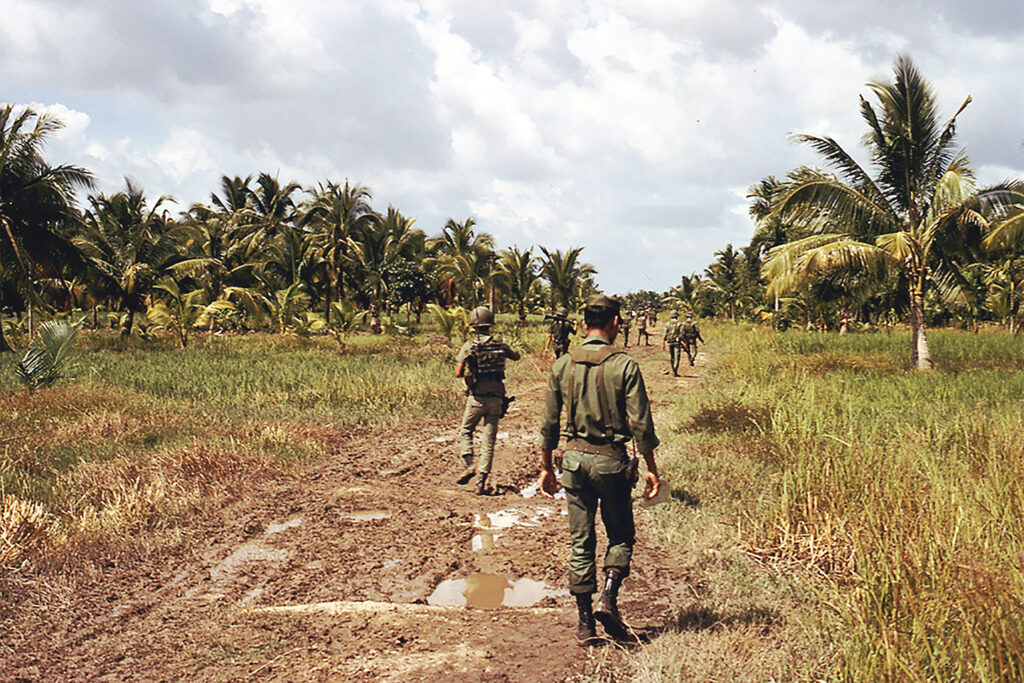
Manh and I knelt on the road with his radio operator while he called the ARVN side of the joint VN-US Tactical Operations Center (TOC) in the provincial capital of Ben Tre to request a medevac flight. He was told that no VNAF helicopters were available. Visibly upset at the rejection, he turned to me and asked, “Can you help?”
A Life or Death Dilemma
I knew at once that this was a test from Manh. Was his adviser truly willing and able to help him when help was really needed? I was fully aware of the MACV policy on medevac for Vietnamese casualties. Yet, in an important and very favorable coincidence, I also knew that a U.S. Army UH-1 (Huey) helicopter was on the ground at adjacent Huong My District. This helicopter was detailed to transport the MACV Inspector-General (IG) team on inspection missions.
I believed the wounded Vietnamese soldier would die if he did not get prompt medical attention. I refused to remain silent and let this man die for lack of a Vietnamese medevac. I used my radio to call the American side of the TOC. The duty officer, a captain, matter-of-factly disapproved my request, saying, “You know what the policy is on medevacs.” I argued that this was a life-or-death situation for one of “our” soldiers and that it was critical to have a medevac if he were to survive. I reminded him of the IG team helicopter on the ground less than 10 minutes away and strongly urged that we needed the medevac. He repeated his refusal.
Unknown to me at the time, the duty officer had passed the radio to the newly arrived Advisory Team 88 Operations (S-3) adviser—a major who outranked me. I was angry and frustrated. I outright demanded that the nearby helicopter be requested to fly this medevac. In my sense of urgency over the badly wounded soldier lying just a few feet away from me, my open anger was coming very close to insubordination.
Fortunately, the Huong My DSA broke into the contentious radio transmission at that point and told us to calm down while he asked the pilots if they would be willing to fly the medevac. A few minutes later, he called back to report that the crew had agreed to fly the mission for us and were on their way to take off, with my frequency and call sign, and would contact me after take-off.
The pilot soon radioed me and asked me to confirm our location and asked about the security situation at the landing zone (LZ). Manh’s security platoon quickly organized an LZ on the road where no palm trees could obstruct the landing. I remained on the radio, confirmed to the pilot that the LZ was secure, and described the area. Meanwhile the casualty was prepared for evacuation.
Moments later we all heard the familiar “whup whup whup” sound of the approaching Huey, which came into sight flying over the road. I asked Manh for a soldier to “pop smoke” to show wind direction and the exact spot where we wanted the helicopter to land.
I stepped to the center of the road and raised my rifle with both hands over my head to guide the pilot. Soon the helicopter was on the ground. Soldiers quickly loaded the casualty onboard. Two soldiers—one of them an RF medic—got in to accompany the wounded soldier to the hospital. I stepped onto the helicopter’s left skid and thanked the command pilot for being willing to help with the medevac.
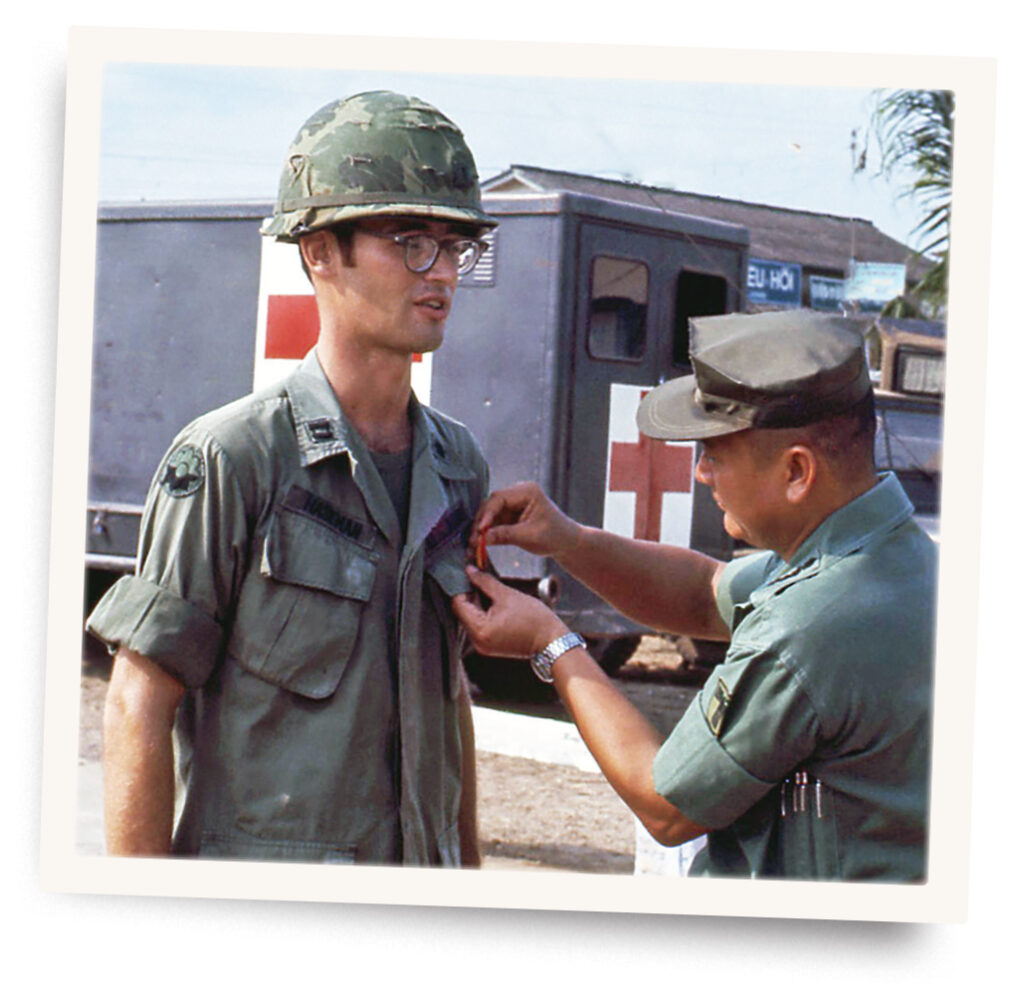
I could not clearly see either the pilot or copilot and did not get their names. I was very grateful that they had come to help when we needed it so badly. I recommended they take off to the north over the rice paddies and definitely not to fly over the distant tree mass until they had gotten high enough to avoid potential enemy ground fire. With that, I stepped back and saluted the crew. The pilot lifted off and the Huey was gone. The entire time from confirmation of the flight to take off with the casualty was only about 15 minutes. Manh quickly got the troops back into formation and the operation continued for the rest of the day. We had no contact with the enemy, and no additional casualties.
Why Deny Treatment to An Ally?
This was an extremely important event for me for many reasons. First and foremost, the medevac was crucial to get the wounded RF soldier to a hospital and hopefully save his life. I was told several weeks later that he had survived but had needed major surgery to amputate his foot and ankle. I was outraged by the unspoken but very real medevac policy corollary: that MACV was willing to deny a medevac to an allied soldier—in this case, a man who would probably have died from severe injuries—just to attempt to make the Vietnamese air force do their job better.
I knew well that, as an adviser, I did not command the RF/PF soldiers fighting alongside me. Nevertheless, I thought of them all as “my” soldiers—my brothers-in-arms. We laughed together, cried together, talked together, fought the common enemy together. I trusted them to be good soldiers and to protect me as best they could. I would do everything I possibly could to keep them alive. Therefore, I was especially grateful to the flight crew who willingly agreed to conduct this medevac. I have the highest regard for, and am very thankful for, all U.S. Army aviators, whose skill and responsiveness helped my counterparts and me countless times during my 18 months as a district adviser. They always came when called, regardless of the tactical situation on the ground and the time of day (or night).
Their courage was limitless and deeply respected by us ground soldiers—Americans and Vietnamese alike.
Second, this had been a definitive test by the Vietnamese district chief to determine his adviser’s responsiveness and reliability when assistance was needed. There was no way I could explain that over the radio to the American TOC personnel. Manh trusted me to be there when he needed help, and I had passed his test. No adviser can succeed without establishing trust. Our relationship for the remaining months of my assignment was close, professional, and worked well for both of us in the challenges we would face.
Third, I knew I was in trouble with my advisory team senior officers in Ben Tre. Full of emotion and adrenaline in the dire circumstances, I had openly challenged U.S. policy on handling medevacs for Vietnamese casualties. Perhaps more significantly, I had been intemperate on the radio and was nearly insubordinate to the Province S-3 adviser. Senior officers do not take kindly to junior officers demanding anything.
Fourth, in retrospect, the incident provided the district chief the opportunity to demonstrate his own sense of responsibility and trust in me—and by important extension, to the other members of the Mo Cay advisory team. Several days later I accompanied Manh to the monthly District Chief/DSA meeting in Ben Tre. I was nervous, anticipating perhaps difficult meetings with the Province Senior Adviser (PSA) and the major I had argued with on the radio. As the meeting convened, the Vietnamese Province Chief asked me to stand up. He thanked me for what I had done on behalf of his soldier and commended the outstanding counterpart relationship in Mo Cay District. Manh had told the Province Chief the details of the event, knowing I was probably in trouble with the senior officers on the advisory team. I knew from then on that I could trust Manh to be an outstanding counterpart. His willingness to intercede on my behalf increased my own trust and confidence in him.
“I Would Do It Again”
The PSA thanked me in public—but in private he told me not to do it again. Later that day I met for the first time the major with whom I had argued on the radio. He took me aside and quietly but firmly told me I needed to work on my communications with senior officers. He was correct. I had been intemperate and disrespectful on the radio. During his first tour of duty in Vietnam he was wounded in action during an airmobile assault into the A Shau Valley, and he had earned the right to criticize me.
“Sir,” I said, “I apologize for being disrespectful on the radio. It was a tense moment for me, and an important test imposed on me by my counterpart.” I also told him the restriction on using American helicopters to evacuate Vietnamese casualties was a lousy policy, and I would do it again if I had to. He was a true gentleman. “John,” he replied, “you’re my kind of officer. You are doing a great job. Just work on your communications.” We had a mutually respectful relationship from then on.
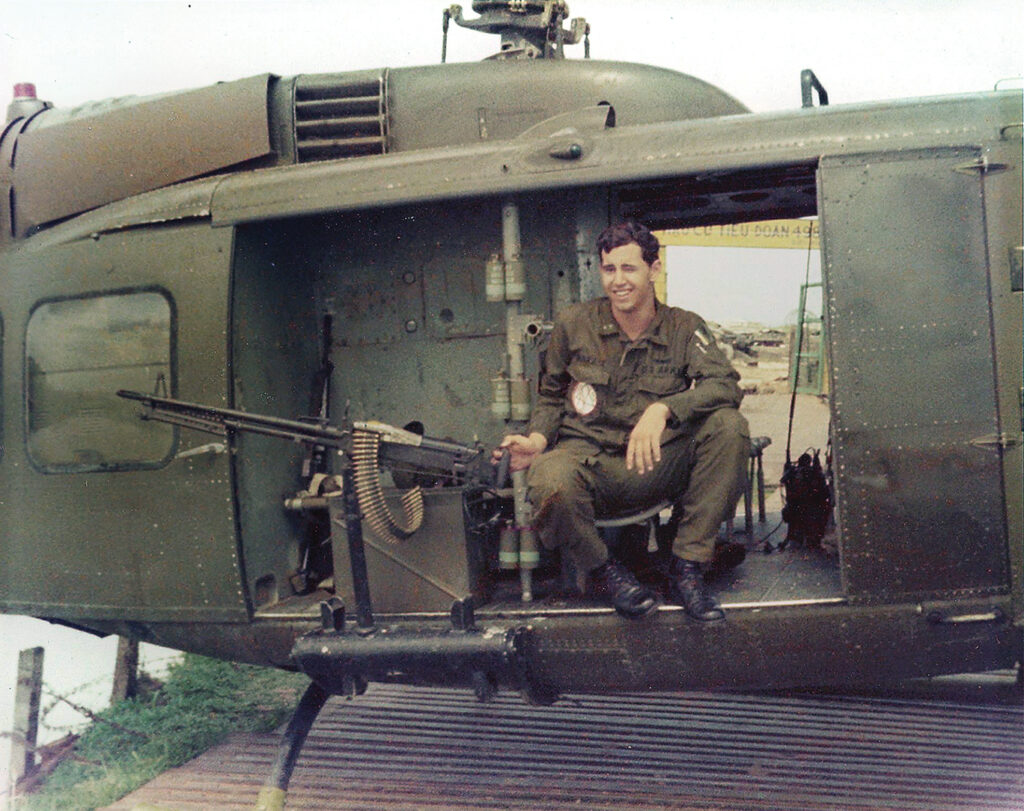
I never forgot that particular medical evacuation among the many I requested for RF/PF casualties during my 18 months as a district adviser in Kien Hoa Province. The event always stood out in my memory.
A little over two months later, in February 1973, my assignment as a district adviser ended when the Paris Agreement mandated the end of the American advisory effort in Vietnam. I spent the final years of my career in Foreign Area Officer (FAO) assignments in Thailand, Indonesia, and Burma, with short stays in the U.S. for language school courses and assignments at Fort Leavenworth and on the Army staff. On Jan. 31, 1995, I retired to my home in western Colorado and embarked on more than 25 years of writing, lecturing, and traveling as often as I could.
In early March 2023 I was a panelist at the annual conference at the Vietnam Center, Texas Tech University. That year the conference dealt with Vietnam in 1973 and the topic assigned to me was my experiences as a district adviser at the end of the U.S. tactical commitment in the war. Just before our panel was to begin, several other attendees were gathered in front of our table and the conversation turned to the topic of helicopter and tactical air support for advisers in the last months of the war. I expressed my thanks to them “for being there when we needed them.” I began to describe the circumstances of that event I had faced long ago, on Nov. 20, 1972, when obtaining a U.S. medevac for a seriously wounded Vietnamese soldier.
One of the men paid particular attention, his eyes getting bigger and bigger as I went along, and then he burst out saying, “I flew that mission!” And thus, on March 3, 2023, I met Chief Warrant Officer-5 (Retired) John M. Harris, more than 50 years after he flew as copilot on that mission, during which he and I had shared a few minutes on the ground on a muddy, rocky road in Mo Cay District in our efforts to save the life of a soldier.
The Rescue Pilot
John Harris flew that humanitarian tactical medevac mission more than 50 years ago. He had been voluntarily activated the previous August as a novice 20-year-old WO1 Army Aviator from an Army Reserve troop unit, specifically for duty in Vietnam. He was later advised that he was the last USAR soldier mobilized for Vietnam.
Before reporting to Vietnam, I had attended the AH-1G Cobra qualification course. As a new Cobra pilot, it was intended that I would be employed in Vietnam as an attack helicopter pilot, most likely in an air cavalry troop. I was eager to get into the fight and see some action. However, soon after I arrived in Saigon I was told that due to recent losses, the immediate needs of the Army trumped my specific training, rank, and orders. I was instead ordered to perform duties as a Huey pilot. On Nov. 8, 1972, I was assigned to the 18th Aviation Company, 164th Combat Aviation Group, 1st Aviation Brigade, based in Can Tho, the capital of Military Region (MR) IV. Our unit’s mission was to provide aviation support to the remaining U.S. advisers who were located in all 16 MR IV provinces; the 7th, 9th, and 21st ARVN divisions; and the 44th Special Tactical Zone (STZ), located along the Cambodian border.
Each day, we would usually put up a dozen UH-1 Hueys whose mission would often be simply stated as, “Upon arrival, fly as directed by the Province Senior Adviser.” These missions included aerial resupply, visual reconnaissance for both tactical air and B-52 strikes, personnel transport, payroll distribution, offshore naval gunfire support, and much more. We were advised that while the medevac of any ARVN soldiers was to be primarily performed by the VNAF, if a PSA should ask us to medevac an ARVN casualty in a time-critical combat situation, the final decision would be up to the U.S. helicopter crew.
On Nov. 20, 1972, I was eagerly performing the duties of a UH-1H Huey copilot, often referred to in Vietnam as a “Peter pilot” or newbie. Our initial mission was to fly as directed for Kien Hoa Province for the first half of the day, followed by support in the afternoon for the 44th STZ, located near Chi Lang. This was my 10th mission in Vietnam. I was trying to learn as much as possible from the aircraft commander with whom I was paired. He was a very experienced captain with two tours in Vietnam under his belt as a pilot. We commenced our support that day by flying a MACV Inspector General (IG) team to various district headquarters. We were on the ground at Huong My District and relaxed in the advisers’ team house as the inspection team went about their work.
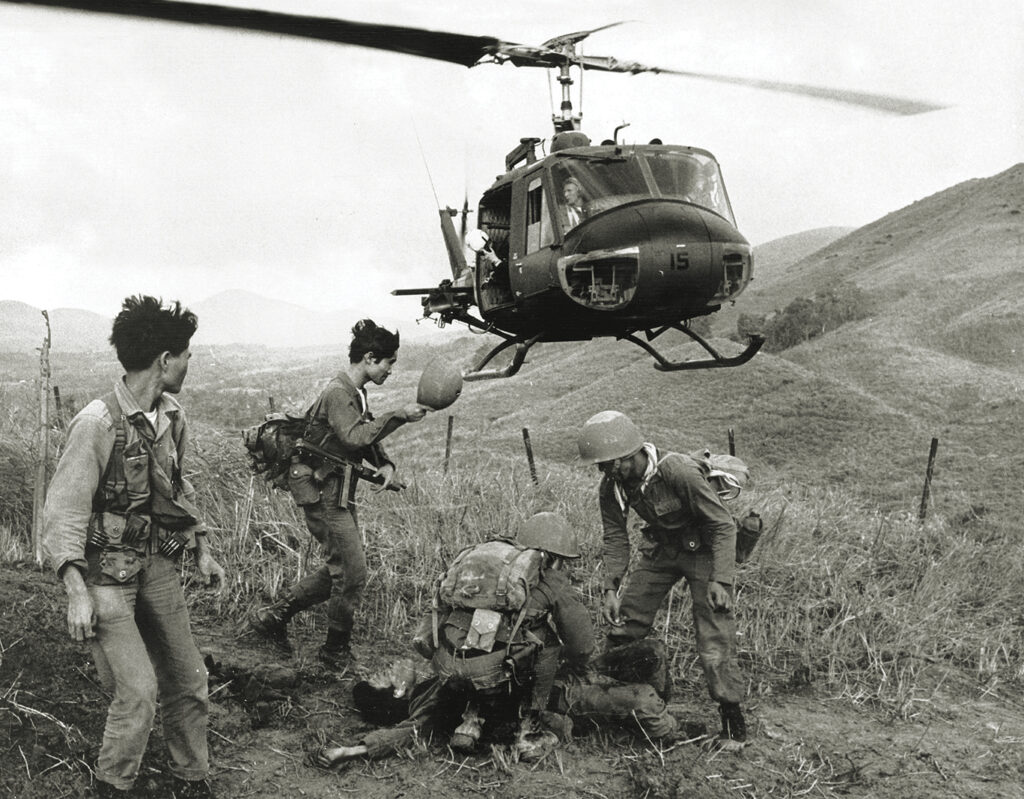
Suddenly we received a call requesting an urgent medevac for a gravely wounded Vietnamese soldier in the adjacent district of Mo Cay. My aircraft commander first asked me, then the crew chief and door gunner, if we were willing to carry out such a mission. Being new and very “gung-ho,” I was frankly surprised that he had even posed such a question. I said we absolutely had to go to the aid of an allied soldier. Both the crew chief and door gunner agreed and off we went.
Approaching the casualty site, we established radio contact with the U.S. adviser, who had his troops pop smoke and identified the LZ as secure. Then we set down following his guidance; he was waving an M16 over his head. During the loading process, I distinctly recall that although the wounded soldier’s leg, which was missing his foot, was covered in bloody bandages, the expression on his face was rather detached from reality. I guessed he had been heavily sedated with multiple doses of morphine to help him cope with extreme pain.
Preparing for Takeoff
As we prepared to take off, the aircraft commander began to direct me to fly to the nearest ARVN aid station. If it had been my first or second mission, I most likely would have simply followed his instructions without comment. But fortunately, while flying a mission a few days earlier for advisers in nearby Vinh Long Province, one of them had pointed out the existence of an ARVN hospital in Ben Tre.
Being rather outgoing, I hastily told the aircraft commander about this hospital and expressed my strong opinion that we should fly there instead of the aid station. I said it would take only a few minutes longer for us to reach it. I then added, “If I get shot down in the future, have my foot amputated and a VNAF helicopter comes to perform my medevac, I certainly hope that he does the right thing and flies me to a fully functioning hospital, versus a simple aid station, which may save my life!”
The aircraft commander acquiesced and allowed me to fly directly to the hospital. We dropped the patient off and I certainly felt good for having asserted myself that day. Once I eventually became an aircraft commander and in charge of my own Huey, I always told the story of this medevac to my new “Peter pilots” and recommended to them that if a similar situation should ever arise, they too should assert themselves and be sure to do the “right thing.”
When reflecting back on my rather abbreviated Vietnam tour, I have always been proudest of asserting myself that day to fly that wounded soldier to a place with a higher level of care. I performed a few more minor medevacs for Vietnamese soldiers during my tour but none of them involved any life-threatening injuries. After the Paris ceasefire took effect, I remained behind for two months and continued to fly as an aircraft commander in unarmed Hueys, conducting peace-keeping missions for the International Commission of Control and Supervision (ICCS), which was composed of military representatives from Canada, Poland, Hungary, and Indonesia. When I finally left Saigon on March 28, 1973, there were only about 500 U.S. troops remaining. They all departed the following day.
An Unlikely Reunion
I remained on continuous flying status as an Army aviator for over four more decades, serving as both a Huey and Cobra instructor pilot/tactical operations officer in multiple assault helicopter companies, attack helicopter companies, air cavalry troops, and other positions. I served for a year in South Korea and deployed for “contingency operations” with U.S. military forces to areas including Somalia, Bosnia, Kosovo, Uzbekistan, Jordan, and Qatar. While in the U.S. Army Reserve, I flew search-and-rescue, medevac, and firefighting helicopters for multiple agencies including the U.S. Forest Service and Kern County Fire Department.
I retired from Kern County in late 2021 after receiving the Federal Aviation Administration’s Wright Brothers Master Pilot Award for safe flight operations for over 50 years. I like to think that after performing that medevac flight in Vietnam, I was forever motivated to perform to the best of my ability in all subsequent urgent missions, both military and civil, to which I was called.
In early 2023, I heard from the Vietnam Helicopter Pilots Association (of which I am a Life Member) that the Vietnam Center & Sam Johnson Vietnam Archive at Texas Tech University in Lubbock, Texas, was hosting a conference focused on the 1973 Paris Peace Accords and the withdrawal from South Vietnam. I was invited to participate on a panel session focusing on the air war in 1973.
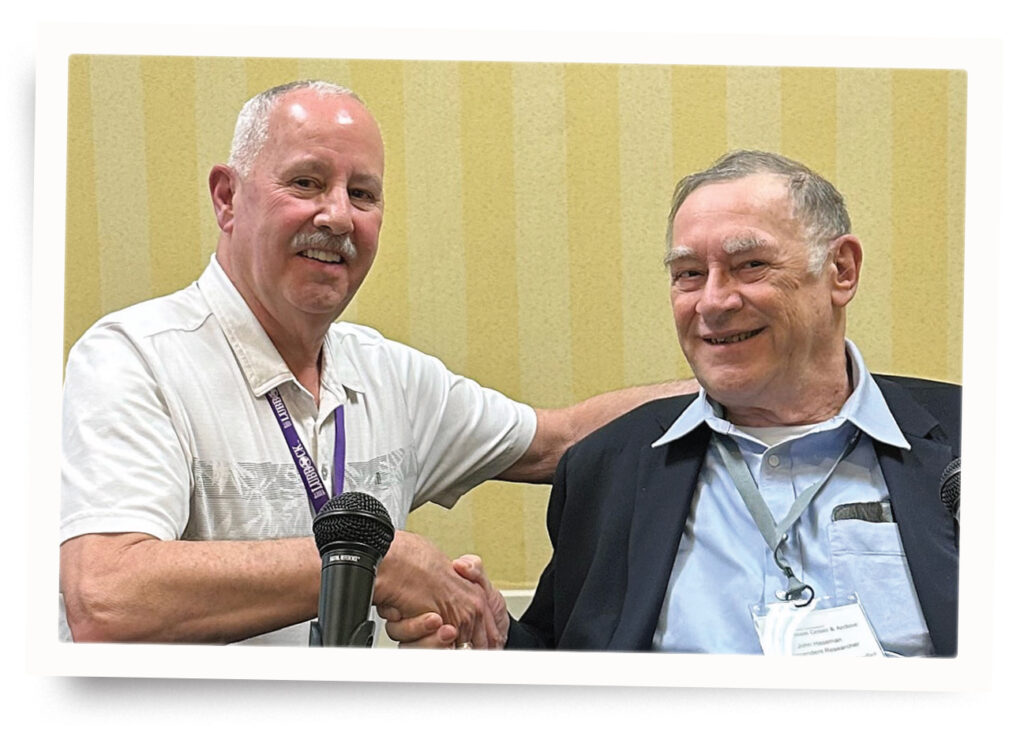
On March 3, the day before my panel was scheduled to meet, I happened to notice there was to be a panel on the “Last Phase of U.S. Advisory Efforts” at the end of the war. As I had flown for numerous U.S. advisers during my tour of duty, I was particularly drawn to that topic. I had a feeling that perhaps one of the advisers at the conference might have been aboard my aircraft during one of our support missions. When I read that one of the presenters, Col. John B. Haseman, had been a district adviser in the Mekong Delta at the same time and in the same area I regularly flew in, I became even more optimistic that our paths may have crossed.
I introduced myself and Haseman began to express his gratitude for both the tactical air support and helicopter assistance he had often received. He then told me the story of one particular mission in which he desperately attempted to get a U.S. medevac for a critically wounded Vietnamese soldier on a patrol with him. As he related the details, the hair on the back of my neck literally began to stand up. I thought, “What could be the chances that he was describing the same medevac mission that I had played a role in?”
When he confirmed that the wounded soldier had lost a foot due to a land mine, I knew it was the same mission. During my planning to attend the conference, I never dreamed I would relive a most emotional mission over 50 years later with the same person I had worked together with to “push the envelope” on the rules and to do the right thing when it came to trying to save a wounded soldier’s life.
John Haseman has authored more than 250 articles and book reviews about Southeast Asia political-military affairs, as well as many book chapters on the subject. He is the author or co-author of five books, the most recent of which, In the Mouth of the Dragon: Memoir of a District Advisor in the Mekong Delta, 1971-1973 (McFarland, 2022), describes his experiences as a tactical adviser at the district level in Vietnam’s Mekong Delta.
John Harris retired from the U.S. Army Reserve in October 2013 as a CW5 with over 44 1/2 continuous years of Army service. He was the last U.S. military aviator from any branch of service who had flown combat missions in Vietnam to have retired while still on military flying status.
This story appeared in the 2023 Autumn issue of Vietnam magazine.
historynet magazines
Our 9 best-selling history titles feature in-depth storytelling and iconic imagery to engage and inform on the people, the wars, and the events that shaped America and the world.


